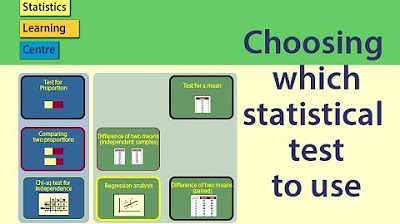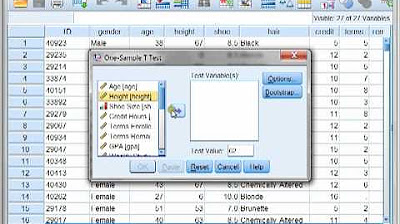9.2.1 Two Means, Independent Samples - Independent and Dependent Samples
TLDRThis video script explores the distinction between dependent and independent samples in statistical analysis. It emphasizes the importance of recognizing whether samples are related or naturally paired, as this determines the appropriate statistical methods for comparing population means. Examples such as data from spouses, twins, and before-after scenarios illustrate dependent samples, while comparing ages of Oscar-winning actresses and actors or volumes of different soda brands demonstrate independent samples. Understanding this distinction is crucial for selecting the right statistical tests.
Takeaways
- 📚 The video aims to explain the difference between dependent and independent samples.
- 🔍 Understanding the distinction is crucial for selecting the correct statistical analysis methods.
- 🔄 Dependent samples are related or naturally paired, whereas independent samples are not.
- 👫 An example of dependent samples includes data from a husband and wife, or twins.
- 📈 Dependent samples can also be 'before and after' measurements for the same individual.
- 🎬 The ages of actresses and actors winning Oscars in the same year are an example of dependent samples due to the shared year.
- 🥤 Independent samples are exemplified by comparing the volumes of 36 cans of Coca-Cola and Pepsi, with no natural pairing.
- 🏆 The heights of U.S. presidential election winners and their main opponents are considered dependent due to the inherent competition.
- 📊 Knowing whether samples are dependent or independent is essential for appropriate statistical analysis of population means.
- 📚 The script will be followed by a video on hypothesis tests involving two population means, which will consider the dependency of samples.
- 👋 The video concludes with a teaser for the next lesson, indicating a continuation of the topic.
Q & A
What is the main purpose of discussing the difference between dependent and independent samples in the video?
-The main purpose is to help viewers understand the distinction between dependent and independent samples so they can determine the correct statistical analysis methods for comparing two population means.
Why is it important to know whether samples are dependent or independent in statistical analysis?
-It is important because the methods of statistical analysis for comparing two population means differ depending on whether the samples are dependent or independent.
What defines two samples as independent?
-Two samples are considered independent if the sample values from one population are not related to or naturally paired or matched with the sample values from the other population.
What defines two samples as dependent?
-Two samples are considered dependent or consist of matched pairs if the sample values are somehow matched based on an inherent relationship.
Can you provide an example of dependent samples from the video?
-Examples of dependent samples include data from a husband and his wife, data from twins, or before and after data for the same individual.
How are the samples of ages of actresses and actors who won Oscars related to each other?
-These samples are related because they are naturally linked by the year that they won the Oscars, making them dependent samples.
What makes the volumes of contents of 36 cans of regular Coca-Cola and 36 cans of regular Pepsi independent samples?
-There is no natural matching between a particular can of Coca-Cola and a can of Pepsi, so the samples are independent.
Why are the heights of the winner of the U.S. presidential election and their main opponent considered dependent samples?
-They are considered dependent because there is a natural matching between the winner and their main opponent, which is a common comparison in such contexts.
What is the significance of understanding whether samples are dependent or independent in hypothesis testing?
-Understanding the relationship between samples is crucial for selecting the appropriate hypothesis tests involving two population means.
What will be discussed in the next video according to the script?
-The next video will discuss hypothesis tests involving two population means, focusing on whether the samples are independent or dependent.
How can the examples provided in the video help in classifying samples as independent or dependent?
-The examples illustrate different scenarios that help viewers understand the concepts of dependent and independent samples, aiding in their classification.
Outlines
📊 Understanding Dependent vs. Independent Samples
This paragraph introduces the learning outcome from a lesson on the distinction between dependent and independent samples. The goal is for viewers to comprehend how these sample types differ and to discern whether samples are dependent or independent. The paragraph explains that statistical analysis for comparing two population means varies based on the sample's dependency. It defines dependent samples as those where values from one population are inherently related or paired with the other, using examples such as data from a husband and wife, twins, or before and after measurements. Conversely, independent samples are not related and are exemplified by comparing the ages of actresses and actors who won Oscars in the same year, which are naturally linked by the year of the award.
Mindmap
Keywords
💡Dependent Samples
💡Independent Samples
💡Statistical Analysis
💡Population Means
💡Hypothesis Tests
💡Matched Pairs
💡Inherent Relationship
💡Natural Linking
💡Treatment
💡Political Parties
Highlights
The video aims to explain the difference between dependent and independent samples.
Understanding the difference is crucial for selecting the correct statistical analysis method.
Dependent samples are related or naturally paired, while independent samples are not.
Examples of dependent samples include data from a husband and wife or twins.
Before and after data for the same individual is considered dependent.
Dependent samples are matched based on an inherent relationship.
Actors' and actresses' ages when winning Oscars are an example of dependent samples due to the year link.
Coca-Cola and Pepsi volumes are independent samples as there's no natural matching.
The heights of U.S. presidential election winners and their main opponents are dependent samples.
The natural link between a winner and their main opponent makes their heights dependent samples.
The importance of identifying sample dependency is emphasized for statistical analysis.
Different statistical methods are appropriate for dependent vs. independent samples.
The video will cover hypothesis tests involving two population means in the next lesson.
The next video will discuss the implications of sample dependency on hypothesis testing.
The video concludes with a summary of the key concepts for dependent and independent samples.
The video provides practical examples to illustrate the concepts of dependent and independent samples.
The distinction between dependent and independent samples is fundamental in statistical analysis.
Transcripts
Browse More Related Video

9.2.0 Two Means, Independent Samples - Lesson Overview, Learning Outcomes, Key Concepts

math 119 Chapter 9 part 2

Elementary Stats Lesson # 21

Choosing which statistical test to use: Practice examples

Statistical Tests: Choosing which statistical test to use

Three Different t tests using SPSS with Dr Ami Gates
5.0 / 5 (0 votes)
Thanks for rating: